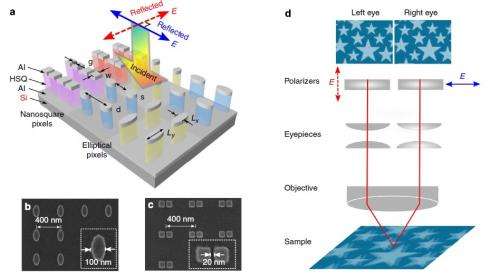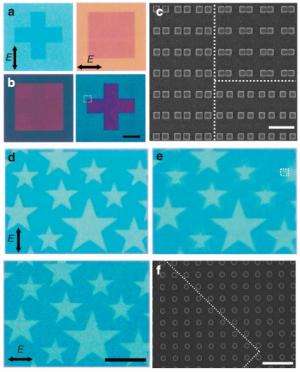November 20, 2014 feature
Researchers create 3-D stereoscopic color prints with nanopixels

(Phys.org) —By designing nanopixels that encode two sets of information—or colors of light—within the same pixel, researchers have developed a new method for making 3D color prints. Each pixel can exhibit one of two colors depending on the polarization of the light used to illuminate it. So by viewing the pixels under light of both polarizations, two separate images can be seen. If the two images are chosen to be slightly displaced views of the same scene, viewing both simultaneously results in depth perception and the impression of a 3D stereoscopic image.
The researchers, led by Professor Joel K.W. Yang, at A*STAR (the Agency for Science, Technology and Research) in Singapore, the National University of Singapore, and the Singapore University of Technology and Design, have published a paper on the new technique for realizing 3D full-color stereoscopic prints in a recent issue of Nature Communications.
"We have created possibly the smallest-ever stereoscopic images using pixels formed from plasmonic nanostructures," Yang told Phys.org. "Such stereoscopic images do not require the viewer to don special glasses, but instead, the depth perception and 3D effect is created simply by viewing the print through an optical microscope coupled with polarizers."
The work is based on the concept of surface plasmon resonance: metal nanostructures can scatter different wavelengths (colors) of light due to the fact that the tiny nanostructures themselves resonate at different wavelengths. If a nanostructure is circular, its resonance is polarization-independent because the diameter of the circle is the same from all directions. However, if a nanostructure is biaxial (such as an ellipse or rectangle), its resonance will depend on the polarization of the incident light. By tailoring the exact dimensions of the biaxial nanopixels, researchers can generate different colors under different polarizations.
Building on these ideas, the researchers in the current study have demonstrated that polarization-sensitive nanopixels that encode two sets of information can be used to produce 3D stereoscopic microprints. To do this, the researchers created nanopixels out of tiny pieces of aluminum a hundred or so nanometers across. The scientists experimented with nanopixels in two different shapes: elliptical and coupled nanosquare dimers (a pair of squares separated by a very small gap).

Because these shapes are biaxial, they exhibit plasmonic resonances at different wavelengths for each axis, with the colors determined almost entirely by the dimension of the axis parallel to the polarization direction. For example, a 130-nm x 190-nm elliptical pixel appears green under y-polarized light and purple under x-polarized light. Comparing the two pixel shapes, the researchers found that the elliptical pixels have a broader range of polarization-dependent colors, while the nanosquare dimer pixels have lower levels of cross-talk, minimizing unwanted mixing of colors.
To demonstrate how these nanopixels could enable high-resolution 3D color microprints, the researchers designed a stereoscopic image containing stars on a 2D sheet by overlaying two slightly displaced views of the same image onto the same area. Then they added an x- and y-polarizer to the eyepieces of a microscope. Viewing the microprint through this stereomicroscope reveals a different image for each polarization, and the combined images appear as a 3D image.
In addition to 3D prints, the polarization-sensitive nanopixels could have several other applications.
"One can envision application of these prints to high-density optical information encoding or holography," Yang said. "3D security elements that are difficult to replicate, and which offer different levels of authentication, could also be generated for anti-counterfeiting and anti-forgery technologies."
The researchers also note that it's possible to make pixels that can encode not just two, but three or more images in a single pixel. For example, nanostructures that have circularly asymmetric shapes could have more than two polarization-dependent resonances due to the additional circularly polarized dimension. The researchers also plan to take steps toward commercialization.
"Moving forward, there is much interest in developing techniques for creating such prints with significantly lower cost and higher throughput, both of which are imperative for this technology to be implementable at an industrial level," Yang said.
More information: Xiao Ming Goh, et al. "Three-dimensional plasmonic stereoscopic prints in full color." Nature Communications. DOI: 10.1038/ncomms6361
Journal information: Nature Communications
© 2014 Phys.org




















